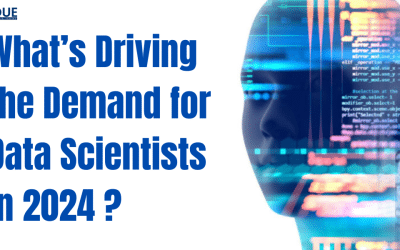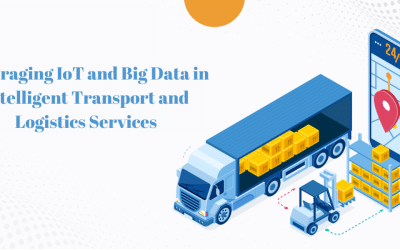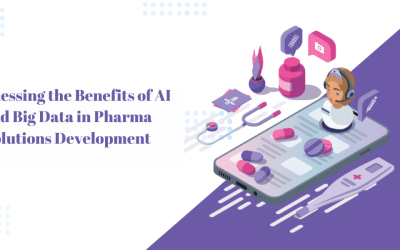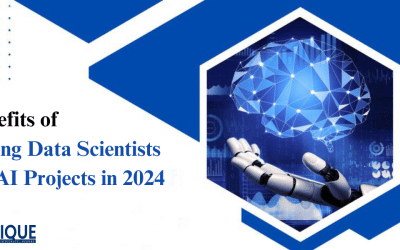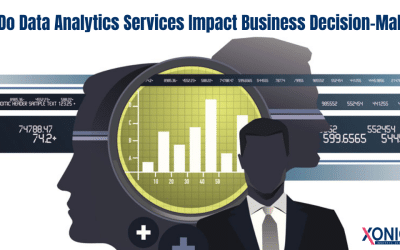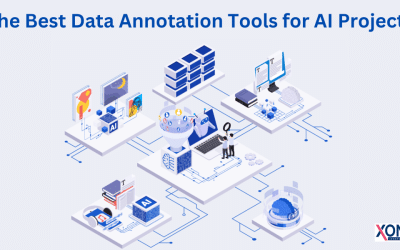If we are talking about the current trend in global technology—artificial intelligence and machine learning—the primary thing we are concerned about is information. Machine learning models’ lives begin with data and end by deploying the model. It turns out that top-quality training data forms the foundation of an effective model. Annotation of data is the act of adding meaningful and useful labels to data that make it easier for machines to comprehend and analyze the data.
Before, Data Annotation Services were less essential than nowadays because researchers were working with the structured data format, which didn’t require many annotations. In the past 5-10 years, data annotation has become increasingly crucial to machine learning systems so they can work efficiently. Without this, machine learning algorithms could be drowned in the sea of unstructured data and unable to discern one element of data from the other.
It is important to note that unstructured data make up an enormous part of today’s data world – such as messages on social media, emails, audio, and image data such as text, sensor data, etc. This makes the function of data annotation extremely important. It is possible to make an ominous claim and say that data annotation is a component of the process of processing data that one should not be unable to afford. Due to AI/ML’s increasing significance and the ever-growing amount of data being generated around the globe, data annotation is crucial for businesses and companies to be ahead of the curve.
Whether you’re new to data annotation or an experienced professional, this article can provide valuable insights into the field and ensure you’re aware of the latest developments.
What Is Data Annotation?
Data annotation refers to tagging, attributing, or identifying data to assist machines learn to understand and categorize the data they analyze. This method is vital to training AI models to understand and comprehend different data types, such as audio files, pictures, video clips, and texts. Imagine a self-driving vehicle based on data from computer vision and natural processing of language (NLP) sensors, as well as other sources for making precise decisions about driving. The data it gathers must be labeled or analyzed to help the vehicle’s AI model distinguish between obstacles similar to other cars, pedestrians, animals, or roadblocks.
When it comes to supervised learning, data annotation is crucial since the more labeled information fed to the algorithm, the more quickly it will learn to work independently. Annotated data allows AI models to run across various applications, including voice recognition, chatbots, and automation, leading to high performance and dependable results.
What Are Data Annotation Tools?
Simply put, it’s an online platform that allows specialists and experts to mark, annotate, or tag data in all forms. It’s like a bridge or intermediate between raw data and the outcomes your machine-learning module will ultimately produce. Data labeling software is cloud-based on-premises or a solution for annotating the best quality training data for machine learning models. Many companies depend on a third-party provider to perform complicated annotations; specific organizations still use their tool made by hand or based on open source or freeware tools available on the marketplace.
These tools are typically built to work with particular types of data, such as images, text, video, and audio. They provide features or alternatives like bounding boxes and polygons, allowing data annotators to label pictures. Users can choose an option and complete the task they are assigned.
Why Use Data Annotation Tools?
Tools for data annotation offer various advantages for Data Annotation Services Company and other organizations engaged in machine learning and AI projects. They transform the labeling procedure, cutting down the time spent on annotation, increasing precision, reducing human error, and ensuring quality. They can also scale and allow easy integration into existing technology.
Utilizing the tools for data annotation, businesses will be able to significantly cut down on the work and time necessary to label their databases. The manual annotation is time-consuming and susceptible to error, but software tools for annotation speed up the process, allowing faster and more effective labeling. This significantly reduces the overall duration and resources needed to prepare data, allowing companies to speed up the AI development and deployment of machine learning models faster.
Additionally, tools for data annotation increase accuracy while reducing human error. Most of these tools offer automatic labeling capabilities, ensuring accurate and consistent annotations across the entire dataset. With the reduction of human intervention, the chance of errors or inconsistencies based on subjective perception decreases dramatically, leading to better-quality training data and more accurate AI models.
What’s More
Quality assurance is an additional essential component of data annotation, and the tools that can be used excel in this regard. They cover a wide data area, efficiently marking every relevant data element. This guarantees that the database is accurate and complete and reduces the chance of bias or unbalanced outcomes in AI models developed based on annotated datasets. Quality assurance systems built into the tools for data annotation aid in ensuring the integrity of labeled datasets, which ultimately leads to improved AI systems performance.
Tools for data annotation also provide the ability to scale, allowing organizations to handle more extensive and complex data. These software tools are built to manage large amounts of data effectively, enabling businesses to process and annotate vast information while maintaining accuracy and speed. Since data sets continue to increase in complexity and size, scaling becomes essential for data annotation software. These tools allow organizations to manage this increase effectively.
Additionally, data annotation tools enable flexibility in integrating with databases and platforms. They’re built to join various databases seamlessly and data management platform APIs, platforms, and machine learning frameworks, allowing easy collaboration between the annotation tools and the current infrastructure. The integration capabilities ensure that annotated data will easily be accessed and utilized in other elements of the AI system, allowing efficient training of models and deployment.
Data annotation tools can provide significant benefits that businesses can benefit from, such as the potential to benefit from AI and machine learning. In addition to reducing time for annotation and improving accuracy while reducing human error, it provides high-quality assurance, allows the ability to scale, and provides flexibility in integration. These tools allow organizations to increase the value of the data they label to create more precise and robust AI models.
Features Offered By Data Annotation Tools
Tools explicitly designed to facilitate data annotation simplify the annotation process and offer all the essential features needed to label data accurately. Below are the most important attributes offered by these tools for the annotation of data:
Image Annotation
Image annotation is a crucial attribute of software for data annotation. It lets users label the image’s items, segments, or areas of interest. The annotation method is widely utilized in computer vision applications like object detection, image classification, and semantic segmentation. It allows the training of AI models to detect the visual features inside images.
Text Annotation
Tools for Data Annotation Tech also provides tools for organizing textual data. Text annotation labels specific textual content components, like entities, sentiments, or intentions. It is commonly utilized in natural language processing (NLP) tasks like recognized entities by name, sentiment analysis, and text classification. Text annotation aids machines in understanding and gaining valuable insights from textual data.
Audio Annotation
Audio annotation is an essential characteristic of data annotation software. It labels different elements of audio-related data, such as speech segments or the sound of occasions. Annotating audio data is vital in developing speech recognition algorithms, audio classification models, and other applications that deal with audio. It aids machines in interpreting and understanding audio data.
Video Annotation
Data annotation tools can provide videos with annotation features to identify items, actions, and events within video frames. An annotation of video plays an essential function in tasks like motion recognition, object tracking, and video surveillance. It allows machines to analyze and comprehend the visual content within video clips.
Multi-Label Annotations
Data annotation tools offer functional multi-label annotations. This function allows users to label or assign tags with multiple labels to objects or elements. This is typically used for objects with various features or is part of several types. Multi-label annotations improve the range and precision of annotated information, enhancing the efficiency of AI models.
Categorization Tagging
Data annotation tools can support categorization tagging, which involves categorizing items according to specific characteristics or categories. Categorization tags allow users to categorize data into various categories or clusters. This allows efficient management and organization of annotations on data. It assists in tasks like exploring data, categorizing content, and discovering knowledge.
Polygon Annotation
The polygon annotation technique is exact and thorough, as provided by data annotation tools. This technique allows users to mark areas or objects with intricate shapes, contours, or borders. It is used extensively for tasks like object segmentation, in-situ segmentation, and fine-grained object recognition. It is a reliable source of spatial data for training AI models.
Data annotation tools are vital features that assist users in labeling diverse datasets for use in AI applications. They improve effectiveness, precision, and adaptability in workflows for data annotation, helping the development of solid AI models.
Trends For Data Annotation Market In 2024
The rising need for labeling data until 2030 is partly due to the rise in machine learning algorithms and tools used in research and commercial applications. Due to the new trends in data annotation, this technology can now be considered one step toward human intelligence in that it relies less on humans and more on itself.
The Demand For Unstructured Data Is On The Rise
Most of the information we keep needs to be more structured. It isn’t easy to handle such data, so one of the major trends this year is taking steps to manage unstructured information for better intelligence and AI capabilities. Although about half of their data is unstructured, businesses embracing an approach to generative AI will see a double rise in the proportion of this data by implementing more chat-based interactions with employees and customers. By 2024, more than 80% of the newly established data pipelines will be crafted to manage unstructured data’s ingestion, processing, annotation, and storage.
Large Language Models (LLMs) Are Growing
Natural Language Processing (NLP) is an important technology that lets humans and machines communicate using well-annotated audio and text information. Text data is utilized in over 70 percent of enterprises due to the growth of chatbots. The annotation of text data can help enhance the capacity of the AI to create patterns in texts, voices, and data semantic connections. The creation of applications that mine text relies heavily on the pre-heated text.
LLMs contributed to the development of NLP this year by providing sophisticated solutions to process and produce human speech. With the advent of GPT-3, which took place around 2023, LLMs are seeing significant expansion, placing them within the top 14% of new technologies worldwide. Concerning audio information, there will be more AI voice assistants (8.4 billion) than the population of Earth by 2024.
Visual Data Does Not Lag
A CAGR of almost 17% from 2020 to 2030, both images and video annotations will remain at the forefront of the field of data labeling. The segment of images mainly causes the growing data annotation market by 2024 because of the increasing utilization of computer vision, which will be estimated to have an amount of $48.6 billion. The affected industries include manufacturing, automotive, healthcare, utilities, energy, entertainment, and media.
For example 2024, software-based facial recognition technologies will be integrated into more than 1 billion mobile devices worldwide. 2.7 million industrial robot sectors operate and require top-quality annotations in creating and testing CV models for the robotic navigation system.
GenAi Influences The Labeling Of The Data Market’s Expansion
One of the most prominent trends in data annotation in 2024 is the wide use of GenAI to improve effectiveness and precision in labeling the data. As previously mentioned, Generative models such as GANs can autonomously make masks or bounding boxes for things in pictures. This will drastically make it easier to do manual annotations and perform tasks like image segmentation.
Generative AI could alter the ways we do our work. About 80% of people believe that GenAI technology can affect 20 or 50 percent of their working hours. Yet, most (63 percent) acknowledge the necessity of developing new abilities or skills before 2024’s end to benefit from this technology fully. Furthermore, generative AI is increasingly being used to enhance human-labeled data. This will automatically label some data, and humans will manage the remainder. This is expected to speed up the annotation process, increase precision, and reduce costs associated with dataset development.
Automation Is Changing The Process Of Labeling
Automation is changing market dynamics and requiring annotators to transition from their basic jobs requiring manual labor towards more efficient and specialized needs, like geospatial annotation. Automation of annotation is expected to expand at an 18.5% CAGR from 2030. Data tools for annotation are proliferating because of the advancements being made in GenAI research, IoT, and ML tools. The 2028 forecast for the global market for data annotation tools is expected to grow at an annual rate of 27.1 percentage points.
However, manually labeling data remains the most favored method in the field, accounting for more than 76% of total market revenues. The process is more expensive since manually labeled data might contain mistakes or errors, and the amount of time needed to identify them could be different.
More Stringent Data Requirements For AI
AI needs data. Not just any data. However, high-quality and annotated data is required for developing sophisticated ML models. ChatGPT has gone through complex transcription and annotation to be a powerful device for 180.5 million users. In addition, specific projects need more accurate information. This means the data annotation specialists will be active in projects specific to the industry, such as data annotation and aviation services.
Additionally, there is a general low confidence level for ML models. This can be attributed to the lack of resources and thorough Quality Assurance (QA). Data teams will have to manage large amounts of data. Therefore, the primary focus is on the edge cases and the quality of control over the labeling process.
What Are The Most Effective Methods For Annotation Of Data?
To ensure the successful development of your AI or machine learning-related projects, you must adhere to the best practices in data annotation. These techniques can enhance the quality and reliability of your annotations to your data.
- Design data labels that are particular enough to be helpful yet general enough to encompass every possible variation in the data set.
- Provide clear and easy-to-understand guidelines on data annotation and best practices for ensuring the accuracy and consistency of data for different annotation tools.
- As annotations can be expensive, it is recommended that we look for more economical alternatives, such as using data collection services that provide pre-labeled data.
- Partner with Data Annotation Company that collects data to collect more data when needed to prevent the accuracy of machine learning models from being harmed.
- If the requirements for data annotation are too big and time-consuming to handle internally, consider outsourcing or crowdsourcing.
- Please use a human-in-the-loop method with an annotation program to help humans focus their attention on the most challenging instances and increase the range of the data set used for training.
- Test your annotations on data regularly for quality assurance reasons. Allow multiple annotations to review their work to ensure reliability and accuracy when labeling data sets.
- If you note sensitive data files, such as images of patients or medical records, you should thoroughly consider the privacy implications and ethical concerns. Please comply with local regulations to protect your business’s reputation.
Following these best practices for data annotation will ensure that your data sources are precisely labeled, readily available to data scientists, and ready to be used in your data-driven ideas.
What Is The Future Of The Data Annotation Tool Market?
The Data Annotation Tool market is growing significantly thanks to the demand for labeled data for machine learning and AI applications. With companies continuing to invest in cutting-edge technology for artificial intelligence, analytics, and applications, the demand for precise and high-quality data annotations will likely propel this market even more.
Market forecasts predict that there will be a steady growth rate as organizations know the value of using labeled data in developing AI models to make informed choices and ensure business growth. The data annotation tool market is proliferating due to the growing need for data labeled for machine learning and AI applications. With companies continuing to invest in cutting-edge artificial intelligence and analytics technology, the demand for reliable and high-quality annotation data will increase.
The outlook for the future of this market is promising due to the continuous development of new annotation tools and the emergence of innovative use cases in diverse sectors. It will continue to grow as companies realize the significance of using labeled data in developing AI models to make informed decisions and help drive their business’s success.
Conclusion
The amount of information generated each day is increasing exponentially. There is a chance that 2.5 million bytes of data are produced each day, which is massive! Data annotation can help companies understand the information and use it more effectively. At the moment, all data annotation applications require humans to be involved at some point. We can complete this procedure as technology improves and we get better at it.
Tools for data annotation play a vital part for data annotation tools in AI and ML initiatives. They help ensure the correct data annotation, improving models’ accuracy and training data for AI-powered devices. The tools provide distinctive features and pricing options to meet customers’ requirements. Companies can gain valuable information and advantages by using data annotation tools. Data scientists can use these tools to create robust predictive models. Likewise, developers can create efficient algorithms and applications. Researchers can use the tools to create data annotations for their AI and ML projects.
Particular requirements and factors must be considered when selecting an annotation tool. The user experience, essential options like privacy settings, collaboration and collaboration choices, and monitoring of performance metrics must be part of the process. If you choose the appropriate software, individuals and businesses can simplify the data annotation process and unleash the full possibilities of AI initiatives.





